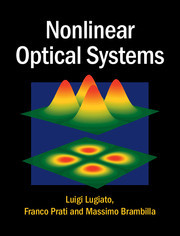Description
Nonlinear Optical Systems
Authors: Lugiato Luigi, Prati Franco, Brambilla Massimo
An in-depth exploration of the dynamics of lasers and other relevant optical systems for graduate students and researchers.
Language: English
Subject for Nonlinear Optical Systems:
Approximative price 88.34 €
In Print (Delivery period: 14 days).
Add to cart
Publication date: 03-2015
464 p. · 19.5x25.3 cm · Hardback
464 p. · 19.5x25.3 cm · Hardback
Description
/li>Contents
/li>Biography
/li>
Guiding graduate students and researchers through the complex world of laser physics and nonlinear optics, this book provides an in-depth exploration of the dynamics of lasers and other relevant optical systems, under the umbrella of a unitary spatio-temporal vision. Adopting a balanced approach, the book covers traditional as well as special topics in laser physics, quantum electronics and nonlinear optics, treating them from the viewpoint of nonlinear dynamical systems. These include laser emission, frequency generation, solitons, optically bistable systems, pulsations and chaos and optical pattern formation. It also provides a coherent and up-to-date treatment of the hierarchy of nonlinear optical models and of the rich variety of phenomena they describe, helping readers to understand the limits of validity of each model and the connections among the phenomena. It is ideal for graduate students and researchers in nonlinear optics, quantum electronics, laser physics and photonics.
Preface; Part I. Models, Propagation, Steady-State Phenomena: 1. Rate equation model for the laser; 2. Interaction of a system of two-level atoms with the electromagnetic field; 3. The Maxwell–Bloch equations; 4. Inclusion of the irreversible processes in the atomic equations; 5. Linear and nonlinear propagation in irreversible Maxwell–Bloch equations; 6. Optical nonlinearities: materials with quadratic nonlinearities; 7. Optical nonlinearities: materials with cubic nonlinearities; 8. Optical resonators: the planar ring cavity, empty cavity, linear cavity; 9. Nonlinear active ring cavity: the ring laser, stationary states; 10. The adiabatic elimination principle; 11. Nonlinear passive ring cavity: optical bistability; 12. Modal equations for the ring cavity: the single-mode model; 13. Single- and two-mode models; 14. Nonlinear dynamics in Fabry–Perot cavities; 15. Inhomogeneous broadening; 16. The semiconductor laser; 17. Laser without inversion and the effects of atomic coherence; Part II. Dynamical Phenomena, Instabilities, Chaos: 18. Some general aspects in nonlinear dissipative dynamical systems; 19. Special limits in the single-mode model; 20. The linear stability analysis of Maxwell–Bloch equations; 21. Adiabatic elimination in the complete Maxwell–Bloch equations; 22. Dynamical aspects in the laser; 23. Single- and multi-mode operation in inhomogeneously broadened lasers; 24. Dynamical aspects in optical bistability; 25. Self-pulsing in other optical systems; Part III. Transverse Optical Patterns: 26. Gaussian beams and modes of cavities with spherical mirrors; 27. General features about optical pattern formation in planar cavities; 28. The LL model; 29. Spatial patterns in cavities with spherical mirrors; 30. Cavity solitons; Appendixes; References; Index.
Luigi Lugiato is Professor Emeritus at Università dell'Insubria, Como, Italy. He has received numerous honors as a result of his many pioneering contributions in nonlinear optics and quantum optics. These include the Albert A. Michelson Medal of the Franklin Institute, the Quantum Electronics Prize of the European Physical Society, the Max Born Award of the Optical Society of America and the Fermi Prize and Medal of the Italian Physical Society. He is member of Academia Europaea and a Fellow of the Optical Society of America, the American Physical Society and the European Physical Society.
Franco Prati is an Associate Professor at Università dell' Insubria, Como, Italy. He has worked in laser physics and nonlinear optics since 1987. His main contributions concern the study of temporal and spatio-temporal instabilities in nonlinear optical systems. He is co-author of more than 80 papers in peer-reviewed journals, and he is an Outstanding Referee of the American Physical Society and member of the Optical Society of America.
Massimo Brambilla is an Associate Professor at Politecnico di Bari, Italy. He has worked in nonlinear and quantum optics since 1986, participating in the early studies of optical pattern formation and dynamics and contributing to more than 100 journal papers and numerous conference presentations. He is active in the theoretical research of nonlinear optical systems, with a special focus on spatio-temporal dynamics of the coherent field and solitonic phenomena. He is a member of the Optical Society of America.
Franco Prati is an Associate Professor at Università dell' Insubria, Como, Italy. He has worked in laser physics and nonlinear optics since 1987. His main contributions concern the study of temporal and spatio-temporal instabilities in nonlinear optical systems. He is co-author of more than 80 papers in peer-reviewed journals, and he is an Outstanding Referee of the American Physical Society and member of the Optical Society of America.
Massimo Brambilla is an Associate Professor at Politecnico di Bari, Italy. He has worked in nonlinear and quantum optics since 1986, participating in the early studies of optical pattern formation and dynamics and contributing to more than 100 journal papers and numerous conference presentations. He is active in the theoretical research of nonlinear optical systems, with a special focus on spatio-temporal dynamics of the coherent field and solitonic phenomena. He is a member of the Optical Society of America.
© 2024 LAVOISIER S.A.S.




